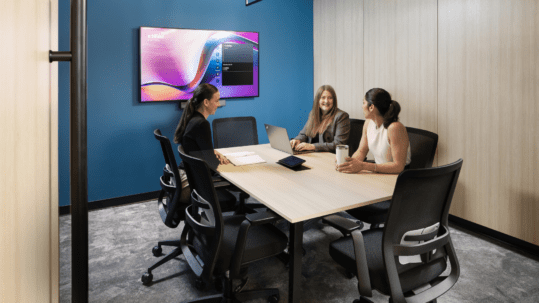There are several factors to consider when planning an office renovation. The most significant factor when it comes to remodeling the office is ways to improve the client and employee experience. When thinking of ways to improve staff morale and satisfaction, some obvious considerations come to mind, such as flexible hours, office amenities, and stellar benefits. Aside from these characteristics, there are some components of employee happiness that are more subtle but no less significant. Among them is the type and amount of lighting used in the workplace. The right lighting can make an office space more functional, comfortable, and stimulating.
This article will go in-depth about lighting in the workplace, focusing on why it is crucial, the risks of poor lighting, how lighting can boost productivity, and the various lighting options for different work environments. Read on to learn more about this week’s WorkSpace Solution: office lighting.
Why is lighting Important
Improper illumination, whether too little or too much, can cause several issues. As employees return to the workplace and spend eight hours a day in artificial lighting, their bodies and minds suffer. Weak workplace lighting can cause eye fatigue, vision problems, and headaches. Conversely, excessive brightness can generate a glare, which can cause migraines and eyestrain. Both can lead to excessive amounts of errors, poor quality, and low productivity at work. Furthermore, research shows that quality workplace lighting increases productivity and reduces errors.
Mental health and occupational well-being have recently received a considerable amount of attention. Research has shown that supplying lighting that mimics natural daylight, supplying proper levels of illumination, and offering customizable lighting that can be adjusted based on individual biodynamics and the task at hand can significantly improve employee well-being. Therefore, managers and business owners must understand how indoor lighting affects mood and cognition if they want to maximize output while supplying a safe and healthy working environment.
Employees can be directly impacted by lighting. Workers can be affected positively or negatively by workplace lighting. Here are some examples of how lighting can affect employees:
Positive effects
- Great Mood
- Alertness
- Performance
- Memory retention
- Better Sleep when they go home
Negative effects
- Headaches
- Tiredness
- Eyestrain
- Bad Mood
Office Lighting Best Practices
Combine Lighting Systems
Truly excellent office lighting is a blend of direct and indirect light sources. With direct lighting, the light shines directly onto the work surface. Conversely, indirect lighting partially illuminates the workspace through ceiling lights, which act as reflectors and distribute the light evenly throughout the room. Combining diverse light sources, hues, and radiance is recommended for the best results. Finding the best lighting, according to Carlos Basa, Director of Sales and Marketing for Symmetry Lighting, is a “combination of lighting systems using fixtures that supply visual comfort and building automation controls that allow individuals and groups to control the lighting around their environment.”
Check out: SPX
SPX offers fixture or group level control ability to configure lighting to the space requirements and flexibility to add, move, or change fixtures.

Image by Lithonia Lighting
Different workstations require different lighting
Lighting in the workplace cannot be designed to be one-size-fits-all. Lighting should be intended for the tasks people are doing in that environment; thus, different workstations require different lights and lighting combinations. Collaborative spaces require more general lighting that can satisfy many occupants. On the other hand, private offices must cater to the people who use them and supply individual control to change the lighting output or effect as desired. Meeting and conference rooms are more technologically advanced than ever, thanks to the rise of hybrid and remote work. As a result, using visual comfort techniques to supply comfortable lighting is critical for maximizing camera and video quality.
Check out: Fresco
Fresco allows for lighting controls that can enhance any space.
Color temperature influences mood
Color rendering and temperature, alone or in combination, can significantly impact mood, both positively and negatively. Cool white light with a high intensity promotes focus and concentration. Warmer white light with a lower intensity promotes collaboration and relaxation. Warmer yellow or orange lighting is recommended for relaxing environments such as a lounge area, the kitchen, or communal areas for conversation. Cooler blue and white lights are better for working, waking up, and concentrating in workstations and private offices.
Check Out: Rubik
Rubik can be modified to create unique designs and has tunable lighting and colour effects to improve mood and alertness.

Image by Mark Architectural Lighting
While you may not realize it, good office lighting can significantly affect employees’ productivity. Proper lighting not only reduces the likelihood of various health issues for staff, but it also increases productivity and workplace safety. Speak to a commercial design-build company to find out how you can optimize the lighting in your new space. Contact Us for more information today.






